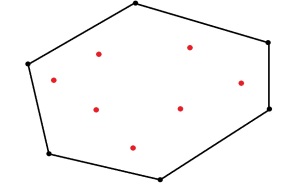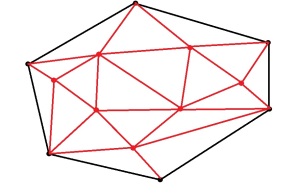In my capstone class for future secondary math teachers, I ask my students to come up with ideas for engaging their students with different topics in the secondary mathematics curriculum. In other words, the point of the assignment was not to devise a full-blown lesson plan on this topic. Instead, I asked my students to think about three different ways of getting their students interested in the topic in the first place.
I plan to share some of the best of these ideas on this blog (after asking my students’ permission, of course).
This student submission comes from my former student Conner Dunn. His topic, from Geometry: finding the area of regular polygons.
How can technology be used to effectively engage students with this topic? Note: It’s not enough to say “such-and-such is a great website”; you need to explain in some detail why it’s a great website.
A good way to get students into the concept and see it’s real life use is to be given a realistic problem. The natural world doesn’t typically give you perfectly regular polygons, but we certainly like making them ourselves. Better yet, we can make regular polygons of a certain area knowing the methodology behind computing their areas. Using GeoGebra, I can challenge students to construct a regular polygon of an exact area using what they know about the use of equilateral triangles to compute area.
For example, let’s say I ask for a hexagon with an area of 12√3 square units. While there’s a few strategies of constructing a regular hexagon that Geometry students may know of, the strategy to shoot for here is to recognize this means we want a hexagon with a side length of 2 then construct the triangles. GeoGebra allows for students to use line segments and give them certain lengths, as well as construct angles using a virtual compass tool. Below is the solution to this example by constructing 6 equilateral triangles (each with an area of 2√3 square units) to form the regular hexagon.

How does this topic extend what your students should have learned in previous courses?
By the end of the unit, students will have learned the formula for finding the area of a polygon (A = (1/2) * a * p, with a being the apothem, and p being the perimeter). But a big part of this unit is how we derive the formula from the process in which we solve the area using this equilateral triangle method. From many previous courses, students will have learned both the order of operations and properties of equality in equations, and we use this previous knowledge to connect a geometric understanding of area to an algebraic one. For example, when we have the idea of multiplying the area of an equilateral triangle by the number of sides, n, in the polygon, we have A = (1/2) b * h * n. It is by the use of communitive property that students can rearrange the variables like this: A = (1/2)h*b * n. And then we conclude that the b*n reveals that the perimeter of the polygon plays a role in our equation. This may seem subtle, but students being fluent in this knowledge helps them work in their geometric understandings much easier.
How has this topic appeared in high culture (art, classical music, theatre, etc.)?
A big part of the method for understanding area of polygons is seeing how we can perfectly fit equilateral triangles inside of our polygons of choice. Perfectly fitting shapes into and around other shapes is something you see in mosaic art everywhere, particularly in Islamic architecture.


While mosaic artists are not necessarily calculating the areas of their art pieces (they might but I doubt it), a big part what makes these buildings so nice to look at is how the shapes fit with one another so nicely. This is an art that’s very intentional in its aesthetically pleasing aroma. This is something I think Geometry students can take to heart when confronting Geometry problems (a just as well with future courses). It’s the overlooked skill of literally connecting pieces together in order to get something we want. In the case of the Islamic architect, what we want is a pleasing building to look at, but math, of course, brings in more possible things to shoot for and equips us with plenty of pieces to (literally) connect together.








